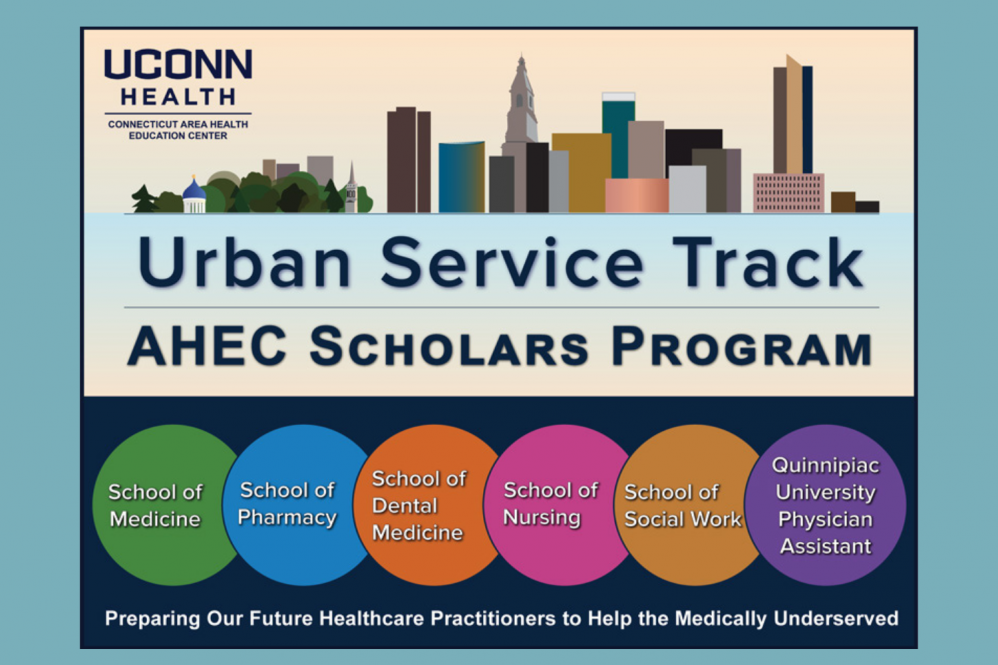“Clinical leadership training is vital to launching the next generation of our health care workforce,” says Raquel Manley, DMD, faculty and alum of the Urban Service Track/AHEC Scholars (UST/AS) Program, located on the UConn Health campus in Farmington. “Effective health care is based upon clear communication, conflict resolution, and teamwork for the health and well-being of our patients and community members. In my experience as an Urban Health/AHEC Scholar, coach, and faculty, I have found that today’s students are often very brilliant academically and in social settings but need coaching and counseling on leadership skills once they enter the workforce.”
So why is this the case?
“Core to the training of health professions students is basic medical science, clinical skills, and assessment. Leadership is often an afterthought or siloed in certain professions, that is unless you are an Urban Health/AHEC Scholar,” says Petra Clark-Dufner, director of CT Area Health Education Center (AHEC), the umbrella organization for the UST/AS Program.
UST/AS is a two-year interprofessional program for health professions students from two Connecticut universities, four campuses and six disciplines. It is grounded in the Interprofessional Education Collaborative (IPEC) core competencies that guide interprofessional education and team-based care for improved outcomes across health professions. Leadership training, in the form of a Leadership Cabinet, has always been at the core of the UST/AS Program, but in 2023, Manley recognized the training needed to be updated to address the needs of today’s students.
“I developed this new Leadership Cabinet curriculum based on two key observations. First, as a student in the UST/AS Program myself, I found that my peers and I learned the most from quick lessons that had immediate real-world applications. Second was my experience teaching at the UST/AS Program’s Clinical Skills Boot Camp. This program educates our Urban Health/AHEC Scholars on hard skills, such as taking blood pressures and doing oral screenings, in a fast-paced, small-group setting. I have witnessed our scholars take these skills and apply them at community health fairs just a few days after learning them. It was clear the students preferred and benefited from fast-paced learning environments.”
Fabio Saccomanno, UConn School of Medicine student and Urban Health/AHEC Scholar, recently participated in the updated Leadership Cabinet and agreed that the new format is a good fit for health professions students. “Small groups best replicate the clinical teams that health profession students will encounter as providers. The fast-paced discussions also adequately simulate the type of efficient and decisive critical thinking that is necessary to have as a leader in healthcare,” says Saccomanno.
The first updated Leadership Cabinet session was held on a Friday afternoon in September and included pre-work so the Urban Health/AHEC Scholars came to the session with some foundational leadership knowledge. They then had the opportunity to apply what they were learning in their small discussion groups. UST/AS Program alumni partners and senior UST/AS Scholars served as facilitators. “The updated Leadership Cabinet program has three mini-skill sessions: leadership styles, navigating difficult interpersonal conversations, and self-care and emotional intelligence,” says Manley.
“We were pleased when we saw that the learner evaluations from this updated training validated its value and effectiveness,” says Clark-Dufner. “90% of the student participants agreed or strongly agreed that the session was valuable; 97% felt the session on difficult communication in the health care setting provided them with techniques to develop their communication skills; 85% felt the session on self-care and emotional intelligence helped them to understand their needs as a leader; and 90% agreed that the training helped them reflect on their own leadership skills to support collaborative practice and identify how to work effectively in a team. The data provides compelling evidence that the updated Leadership Cabinet curriculum meets the learning needs of our students.”
Saccomanno noted each session simulated high-stress situations requiring efficient decision-making, while one in particular addressed a unique situation that health care providers often experience: “Balancing their personal goals with the collective goals of the team. . . . all healthcare leaders will have to make a decision like this during their careers, and it was helpful to have this opportunity to practice in advance,” said Saccomanno.
Clearly, to be effective, leadership training must mirror the situations students will encounter in their careers. “Our students’ main curricula through UConn and Quinnipiac University focus on the ‘what’ of healthcare, while our program instructs students ‘how’ to deliver this care in an interprofessional and personal manner,” says Manley. “This training brings out the human qualities of health care. Often our students are so focused on passing the next exam or practical. This training refocuses the whole picture for our rising health care leaders.”
Saccomanno agrees and believes the updated UST/AS Program Leadership Cabinet curriculum provided Urban Health/AHEC Scholars with a unique opportunity to experience what it will be like to be a leader in a health care setting. “The interdisciplinary nature of the UST/AS Program means many healthcare disciplines were represented, each with their own lens. More opportunities like the UST/AS Program Leadership Cabinet should be incorporated within the curricula of health professions programs to best train the next generation of professionals to care for patients,” says Saccomanno.
“Without these skills our students will not rise into the leaders and communicators our health care system needs to thrive,” concludes Manley.
For more information, visit the Urban Service Track program.



